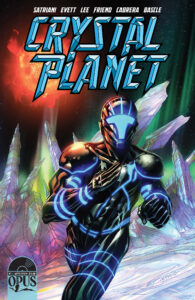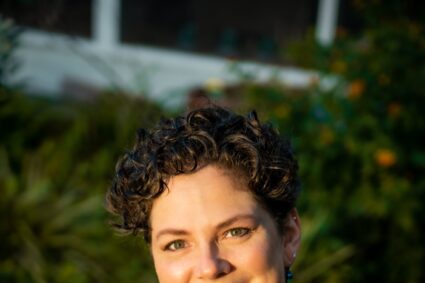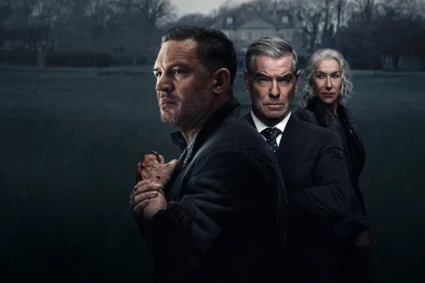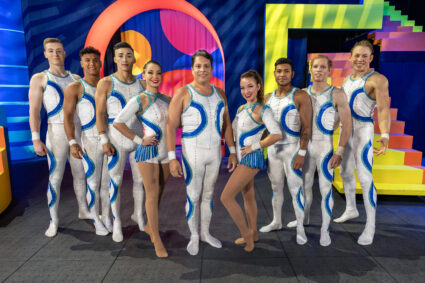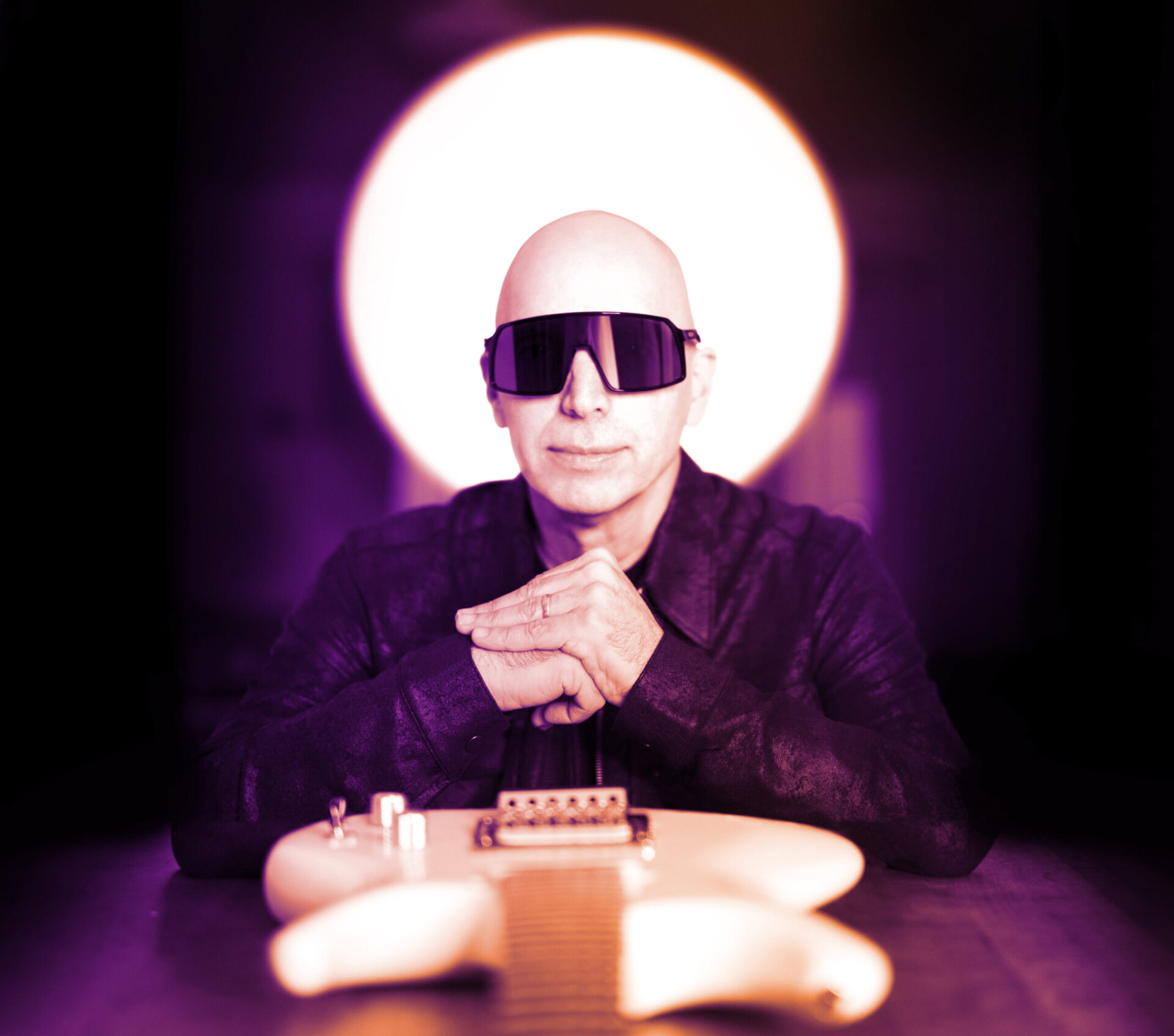
On this edition of THE INTERVUE. Fresh off the heels of his first foray as a touring visual artist earlier this year, with stops to galleries in Florida and New Jersey, world renowned guitarist Joe Satriani is now planning to bring his showings to the DC Metro Area. His next art appearances will be at the Wentworth galleries in both Tyson’s Galleria in McLean, Virginia on Saturday, June 11.
That’s next Saturday from three to 6pm as well as Sunday, June the 12th, 1 to 3pm at the Wentworth gallery at the Westfield Montgomery Mall in Bethesda, Maryland. And I cannot wait to talk to him about one of his pieces especially says he also released his 19th studio album, The Elephants of Mars, to much critical acclaim. Ladies and gentlemen, we have the very own the talented, the multi-talented artist that is Joe Satriani.
Joe, welcome to THE INTERVUE.
Thank you very much. What a great introduction.
Why always give great introductions to people who are bringing some class some culture to the DC metro area, especially with such a talented career as yours. You have done it all. You’ve been to conceptual artist, helping out with comic books, a guitar teacher, performing with Chickenfoot, and you’re an artist and you’re bringing your art to two of our galleries in the DC metro area. And that’s why I want to talk to you first about because you’re such a renaissance man. So, the first question I got asked after looking at some of your work online is how did you get started going from to music to painting?
Oh, I guess they all started pretty much at the same time because I started as a drummer when I was about nine years old, taking lessons, trying to be a serious musician. At the same time being the youngest of five kids, I was surrounded by lots of music and art is my two oldest sisters. wound up getting degrees in fine art. My Father, although he was an engineer was also a talented painter. There were art supplies all around the house and the smell of paint, turpentine and all that along with all the noise that goes along with a family of seven, and a nine-year-old drummer.
So, I was always, you know, coaxed into drawing or trying to paint even though it wasn’t really my thing, I was really dedicated to music, I switched to guitar at 14. My drawings and my aspirations in the art world, were kind of put off to the side a little bit. I only use them to help the different rock bands I was in if we needed images for posters or things like that. Things you know, moved on, and I wonder marrying an artist and then our son also got a degree in art.
As I kept putting a lot of my artwork into the music career, after a while, I decided I really wanted to work with paints and canvases. So, this goes back maybe seven years. So, yeah, I turned to my family. And I said, you know, I need to know like, everything about mixing pain, what means to use, which brushes do what. Up until then it was always drawing, and then maybe digital manipulation, things like that. Making guitar straps, guitar picks posters, T shirts, hats, you know.
So, but this was more fun, because you know, you get your fingers dirty, which is like music, you know, you’re, it’s a real visceral experience. And so, I like the idea of getting messy with the paint. And having these big things that exist in the real world, and you finish them right in front of you. The digital art, you know, go somewhere else, and it gets manipulated. But this type of light reminded me of performing.
Well, that is great to hear. And I love how you made that successful transition from music to art, and that both your wife and your son have really made that transition possible. And I’ve been reading about your Beyond Reality series, which features original campus art and hand painted guitars. And it has a great unique theme. And I want you to tell us about what will your fans what will people who appreciate art are about to see next weekend?
Yeah, this? Well, it’s, it’s so freaky, and so amazing that Christian and everybody at Wentworth Gallery had given me this opportunity, this chance to get my vision on canvas and put up on the walls of the gallery. All the different ideas I have about making a statement with artwork and making stuff that really is provokes a spiritual and a visceral and an intellectual response. You never know which one is going to which button it’s going to push, you know, when film walks in and see something.
That’s what’s so great about art, right? One person can walk in and see a face of an alien. And just think science fiction, the other person who sees themselves or somebody they’re thinking of, you just can’t tell. And it’s very much like music, where, it’s not the musician’s job to try to dictate what people are going to like or how they’re going to react. Your job is to make the music and then kind of give it away and become the property of fan really, on an emotional level, on an artistic level. So, the artwork is the same way.
And so, the collection has got some things that are just completely bizarre. And then other things that you’ve seen before, but perhaps not in that context. So, it swings between strange looking alien, some serious, some whimsical on guitars, to the juxtaposition of common things that we see every day like the flag or a skull or the Statue of Liberty, things like that. It dumped the whole show, I think, is an explosion of artistic freedom.
That’s what it’s so much fun because again, I relate to it like performing. battling the stage with electric guitar, you are improvising a solo you’re catching feedback from the audience. You reacting to it. And so, you never know what’s really going to happen. So, when I look over the whatever, one hundred thirty plus pieces, or part of this traveling show, I’m pretty shocked and amazed. At Mattamy I actually have no explanation for it other than every time I look at it, I have fond memories of the moment that I created and how much time I spent working on.
that’s great to hear. And sometimes you don’t need an explanation of why you have 130 plus pieces, they all feel like multiple children see you. And I hate to ask this question but, of those 130 pieces plus pieces, do you have a favorite among them?
That’s impossible. I know, you had to ask that question. I really do remember, very much like songs where you have a real strong recollection of all the versions that led up to the final version. Where you either resisted that final additional note, or in this case, brushstroke, or something. And its sort of bittersweet, because you realize, I can’t experience this painting as an artist anymore, you know, as soon as I put that last stroke of pain on unfinished.
So, you kind of feel sad that you’re not going to work on it anymore, then you’re sort of filled with this other wonderful feeling that it’s going to go out and people are going to react to it. It’s, that’s really exciting. So, but all of them, like, when I look through them, I just go back to that, you know, I remember when it was just a sketch of myself, and how am I going to do this, you know, how’s it going to turn out. Some of them, when you go to do something with the American flag, you kind of know, on how to do a flag, I know how many stars and stripes and all that stuff. So that you’re manipulating something else you’re playing with some other part of the whole work. But if you’re doing something where you’re scraping colors, across a 40 by 40 Canvas, you really have to improvise second to second. Because as soon as you start doing something with paint, it’s suddenly reacts to your movement, and you have to react to it.
And there’s about a three-minute window where so much happens. It’s really exciting. And again, I bring this up a lot, but it’s like doing a guitar solo, in front of an audience where you can practice and memorize the notes and all that, but nothing will prepare you for the unknown that will happen soon as you start it. Because it’s that you can only prepare so much. And then you have to react seconds a second to see if you can make that solo really reached people in the audience.
In this particular case, using you know, preparing a canvas with images and drawings, and then doing things great, really happy. I kind of hyperventilate when I’m doing it because it’s just so thrilling. And yet, I’m a bit anxious to see exactly how the colors are going to turn out. And then as you sit there and watch it dry and become something, it’s, it’s really, I find it really exciting as you can tell. I love the process. That’s why I got into it. That’s why I had that feeling like I want to get like get the paint underneath the fingernails and messy and create something that’s real. Process is just so real. So yeah, when I look at these, I see those big ones with the guitars and the wild colors. I remember moments when I stood back and when done, its excitingly
Your new collection which is one of the things I really enjoyed reading and looking at, has engaged the love of aliens and space themes. While exploring more abstract aspects, I want to know do you have a favorite science fiction movie or a series that you’re enjoying you fall that inspired you to create this alien Space Them world that we’re about to see.
I think Sunshine, not too old sci fi movie was really a brilliant take on, on science fiction. I come from a background of reading science fiction when I was a little kid. So Ray Bradbury would have been, like some of the early stories that I read in the back of the old days, and then I moved on, you know, to ace moth, and then a highland, and all of those guys from the beginning and then got into Kurt Vonnegut, which I know a lot of people don’t see as science fiction, but he actually was sort of half science fiction, perhaps at times, really broke the barrier between reality, fiction and science fiction, and created a new form, as he sort of disassembled the whole novel concept.
Then, modern day, there are writers like China Mizel, that are absolutely amazing. And command of the language and the intensity of ideas page after page, just really stunning. I love science fiction writers, which is why I started a company with a good friend of mine that evidence, right time success stories, yes, we’re actually putting together our first book, wound up with about 25 to 30 properties that we really wanted to shop. And we thought, let’s just pick 10, and put them in a book and start from there.
One of them is already in production. That’s Crystal Planet, comic books out there with Association Metal. And that’s been great to see a simple idea that got started with a song turned into a full-blown comic book series. And by the end of the year, it will be a graphic novel, really. So always really exciting to work on stuff like that. All the creative elements of what I do, and to be able to collaborate with friends who are just crazy creative, is like, fantastic singer songwriter, really dynamic performer on stage. And man can he write! He is so gifted at writing is putting all crazy ideas, whatever I bring to him, you know, in 24 hours, he’s got a script going already.
Well, that is great to hear, especially since I’m a huge science fiction fan, both of the literature, television and movies. It’s great to hear that you mentioned some of my favorite science fiction authors growing up, and that you are bringing the love your love and your passion of science fiction into work. I have to tip my hat to you, sir.
Great. That’s great. Well, it’s always great know that someone else is in love with science fiction.
Oh, yes. And let’s talk about your newest album, The Elephants of Mars, which was your 19th studio album, and you had the chance to work with your bandmates Bryan Beller, Kenny Arnoff and Erik Caudieux. And among the songs that I loved was Faceless, which the melody, it’s so addictive. I put it on my iTunes, I’m loving it. And I want you to tell us how did you come up with not only the concept of the album, but that particular melody for Faceless?
Oh, thank you. Well, the concept of the album actually came together before the title track was written. And, the concept really was a reaction to the fact that I completed a record called Shapeshifting started sort of release campaign and had a tour booked. Then just like everybody else in the world suddenly had to stay home. So, this goes you know, we finished everything right at the end of 2019. He shot that video for me for the song 1980. And then the rest is sort of history.
As I realized that, we were going to be at home fighting the pandemic for quite a while. I thought it would be right to not only release the Shapeshifting album anyway, even though we weren’t going to be able to do a rewrite, and to get busy rein myself once again, to come up with another album that I would try to push myself to excel in areas that I thought I should just sort of try to push myself in something personal. So, the concept, believe it or not, you know, write better songs, arranged better and play better guitar and get more interesting sounds, and put a team together that wanted to do the same thing. And somehow do it in a way that we’ve never done it before, which was remotely all over, get gathering performances from the artists all over the world.
You mentioned the musicians, most of which are in the LA area, I’m up in San Francisco, my new keyboard player was in Australia. So, the good news about it was that we had all the time in the world, compared to the usual, like, get it done in 10 days. Which is usually when you make a record, there’s so much anxiety about the budget, that you have to get in and out really fast, make decisions hard and fast, hour after hour, just so you can stay in budget and stay on schedule. So, we were free of those concerns. And that really helped me I have to say that I felt more relaxed being alone, being able to sort of bare my soul a little bit more on all of the tracks. And this really helped with the song that you mentioned on faceless.
You know, normally I because I’m a kind of a shy person, I bet that if I was in the studio, and I haven’t played that I would keep you know, 50% of myself, my emotions guarded. Because I wouldn’t feel self-conscious, in a room with four or five people watching them play and commenting on this. I know that about myself, I can’t help it. But if I’m alone, and I can record a melody, that heartbreaking that I want to sort of break down in the middle of one take, I can do it. Poke fun at me for being, you know, over emotional about something or making a mistake or something. And I started to notice that as I was recording the album that I was getting more of me on all of the tracks. And that was because I felt more comfortable alone.
And opening up and a song like Faceless, which really isn’t about people having their faces covered. But it was inspired by the fact that as I walked around my town, my neighborhood that we all, all of us who know each other were in the community, suddenly, no one’s really saying hello, and stopping and talking and we became faceless. I started to think about that in normal life. It’s a terrible state to be in, if you feel that you’re not being recognized for who you really are. And it’s made even worse if it’s that person that you consider your most significant other.
And go wow, that’s something that I want to get into. I want to put music to that feeling about someone who feels their true self is not being recognized. they don’t know why they don’t they want to solve it, but they’re not quite sure how. How to do that. it was a song that was that I wrote on keyboards first. And then started to apply the guitar as delicately as I possibly could, you know those ballads are the hardest things to play because there’s a very thin line between being expressive and over playing.
If you’re playing a song that’s meant to get people up on their feet, kind of be excessive. You kind of get a free pass for overdoing it. But not without it. It’s always you have to be very attentive to every single thing about it. It really was heartwarming that as the track was sent down to Eric, Kenny, and then to Brian and to Ray did everybody got what I was trying to get across. And everyone came back with performances that were just perfect.
That’s great. I can listen to you all day with this album and be amazed and be very impressed by your work is such a wonderful album, and I’m so glad that it’s gotten the acclaim it truly deserves. My next question is, how much has your perspective on guitar changed over the years since you’ve been playing guitar for decades now. And not only that you actually taught some students who’ve actually gone to be great guitarists themselves like Steve Vai, who’s actually coming to our area later this fall. So, I want to know, how has your perspective changed on the guitar?
Oh, you know, when you start out, it’s usually because of a couple of things, a couple of players that you like, a couple of bands, things like that. Then as you as you get into it, you, you start to recognize that there are these other players around the world that are doing things that you also find attractive, and you want to get in on it, they make you feel good. You are attracted to it on a visceral level, or maybe on a sort of a musical intellectual level, you start to recognize, “Wow, that’s special, unique. And I don’t know how to do that.”
I want to figure that out, you know, this is where the music education comes in. And it’s really helpful because it opens doors, adding your creative components that you can later draw upon as you become a professional. I would say that every time some new guitar player would come along, or I would be made aware of a guitar player that existed, thirty years before my time, I would really soak it all up. And, a good example is, as I was growing up, you know, my parents were Jazz Age kids, grew up and had a family.
So, there was always jazz playing alongside classical music. So, I heard Beethoven and Mozart and I heard Miles Davis. And Johnny Hodges & a lot of West Montgomery, guitar playing in my house. When I started getting into Hendrix, it was easy to see the connection between Jimi & Wes, the impact that was that we had on the Hendrix. And so, I would put, two and two together, and that would change how I learned and what I liked. And every time that happened, whether it was Allan Holdsworth or John McLaughlin, or Tommy Iommi, or other blues players, like what my brother was getting into, when I was young. He was really getting into blues harp and other blues artists from middle of last century.
And I got turned on to John Lee Hooker and Muddy Waters through my brother. And that was really interesting, because I’ve watched him play blues harp along with the records. And I know, I got to get in on that, because that sounds really great. And it’s really spooky sounding like, the first time you hear John Lee Hooker, it’s really a revelation. It’s some sort of strange musical alchemy. And it’s not filled with a million notes like Beethoven, but it’s still the same thing. It’s music, you know, coming from somebody’s heart. So, it’s, I always found that super fascinating. I tried to turn that over to my students. And I had a great time teaching guitar at the back of a little guitar store in Berkeley, California because the quality of the students was so good.
I was able to teach kids that wound up being in Metallica, Testament, Third Eye Blind and Counting Crows but I knew them as young kids. So, whether it was Kirk Hammett, or Charlie Hunter, it was pretty amazing to watch them get excited about music, just like I was when I was a young kid. We wound up sort of, locking arms together as like a group of friends that were going to experience music together and our lives been really excited.
What would you like to say to the person who would love to be a guitar player would love to continue to craft but they need that extra added guidance from a rock legend like you? What advice would you give?
Well, I’m a big believer in in private lessons. I think the private lesson thing is really great. I’ve always I guess, because I spent even as a teenager, I started teaching Steve Vai when I was just 15 and he was about 12. I know, from experience, that when you sit down with somebody once or twice a week, and you can monitor success, and you can see what the strengths and weaknesses are, you get a quicker result. Now, of course, I was doing all of that stuff before there was internet and any kind of video instruction available to the average person. So today, if you and I wanted to learn a song, we’d probably go to YouTube, and it’d be 1000 variations of it, we could just look at it. There’s a lot to be said for being able to see somebody do something, you know, rather than pulling it from a manuscript or listening to it another time.
So, the internet has helped millions of budding musicians get over that feeling that when they hear something amazing that they can never play it because when they see someone do it on YouTube, they go, “Oh, that person can do it. And I can do it.” True. You have to remember; all music is pretty much made by people. Your people who were the ones who do it, so you’re one of us. So, there should I guess what I’m getting at is that, you know, that mental barrier is huge. You know, its huge people tend to doubt themselves and their abilities, especially when they pick up something as awkward as a guitar does feel a little bit weird to a beginner. You just have to remember that every one of us has the potential to be a fantastic musician, it doesn’t really rely on technical prowess, really, just about your personal drive. That’s what you want to say musically is important to bring to the world.
And that the technique thing works itself out, it really does. There is no one level of technique in order to be able to make music. You need very little technique to make really great music, this is important. I would say that to anyone starting out, just go!
